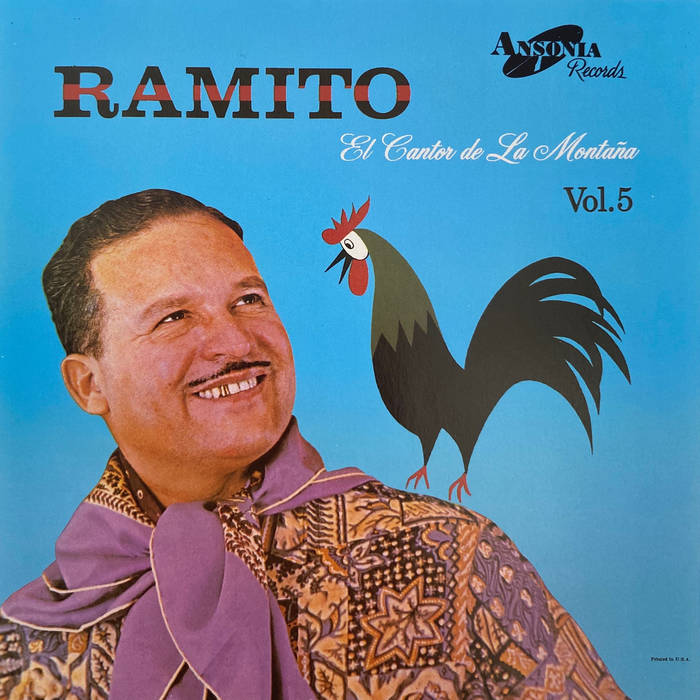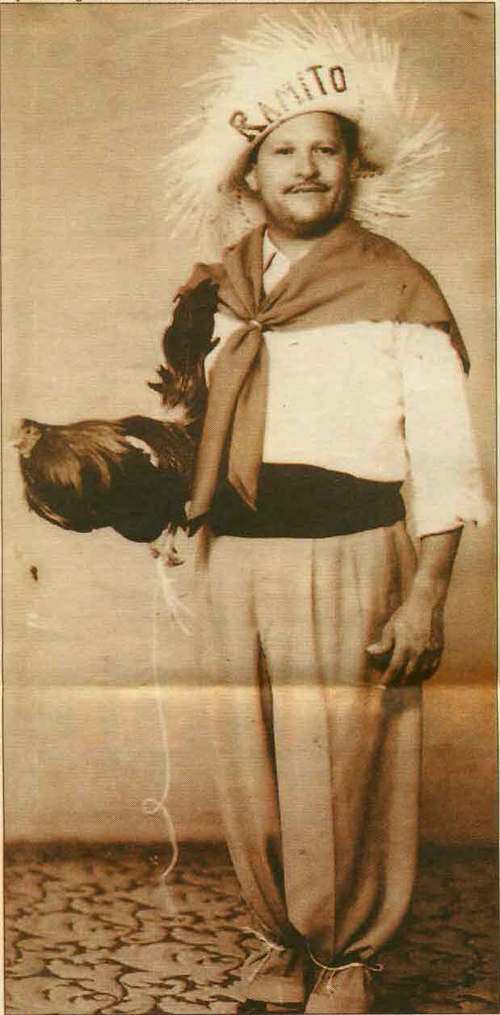

私たちの血(サングレ)
Nuestra
Sangre por Ramito
☆ フロレンシオ(「フロル」)・モラレス・ラモス(1915年9月5日 - 1989年2月23日)は、ラミートとして知られるプエルトリコのトロバドール、作曲家。プエルトリコのカグアス出身。このジャンルのファンは、彼をヒバ ロ音楽の王様とみなしている。「エル・カントール・デ・ラ・モンターニャ」(山からの歌手)として知られるモラレス・ラモスには、ルイス(「ルイスィー ト」)とフアン・マリア(「モラリティート」)という 2 人の兄弟がおり、彼らもヒバロ歌手として高い評価を得ていた。
★
私たちの血潮(Nuestra Sangre)は、アルバム、El
cantor de la montaña に含まれた楽曲である。
| Nuestra
Sangre (Seis) |
|
| Indios de raza aguerrida. Y de bélicos ardores hallan los descubridores allá en mi tierra perdida La mujer de tez curtida de las tribus Borinqueñas Con su mirada halagüeña. Al hombre blanco se luce herminando con su cruce la raza Puertorriqueña Los hijos de tierra Ibera. Cuando a mis playas llegaron los amores conquistaron de la India sandunguera El arrollo y la ribera en el valle y la colina Al blanco que fue su ruina. Le dio su encanto y hechizo y de ellos nació el mestizo con ascendencia Latina Respondiendo a su destino. Sucumbió el Indio tan bravo y entonces al Negro esclavo trajo el Español Ladino Con la Negra fue Mesquino y contra la ley divina El la hizo su concubina. En el solar hogareño y entonces nació el trigueño con mezcla de sangre fina Ahí de África que el sol abraza. Y lava fría ser Tiberia, entre opulencia y miseria se fue fundando mi raza Y allí no es raro si casa un blanco y una trigueña O con la rubia Norteña. Un moreno de prestigio, porque ese tiene un vestigio de la raza Borinqueña |
勇敢な人種であるインディオたち。 そして、私の失われた土地で、発見者たちは、好戦的な情熱を見出した。 ボリンケニャの部族の、日焼けした肌の女性たち その魅惑的な視線。 白人男性は、その混血によって、プエルトリコの人種を誇らしく見せている。 イベリア半島の子供たち。 私の海岸に愛がやってきたとき、彼らはインドのサンダンゲラを征服した 谷と丘の川と川岸 彼らの破滅となった白人。 彼女はその魅力と魔法で彼らを魅了し、ラテン系の血を引くメスティーソが生まれた 彼らの運命に応えて。 勇敢なインディオは屈服し、そしてラディーノのスペイン人は黒人奴隷を連れてきた。 黒人女性に対して彼は卑劣で、神の法に反して 彼女を妾にした。 その家庭で、そして、純血の血が混ざった、肌色の子供たちが生まれた。 太陽が抱くアフリカから。 そして、冷たいティベリア川が、豊かさと貧困の中で、私の人種が築き上げられた。 そして、そこでは、白人と肌色の女性が結婚しても、 金髪の北部の女性と結婚しても、珍しいことではない。 威厳のある浅黒い肌は、ボリンケニャ人種の名残だからだ。 |
| Writer(s): Flor Morales Ramos |
|
| https://www.musixmatch.com/ja/lyrics/Ramito/Nuestra-Sangre-Seis |
★ 関連する用語についてのリンク集
☆
| Florencio
("Flor") Morales Ramos (September 5, 1915 – February 23, 1989),
better
known as Ramito, was a Puerto Rican trovador, and composer who was a
native of Caguas, Puerto Rico. Fans of the genre consider him the king
of Jíbaro music. Known as "El Cantor de la Montaña" (The Singer from
the Mountain),[1] Morales Ramos had two brothers, Luis ("Luisito") and
Juan María ("Moralito"), who also attained major recognition as jíbaro
singers.[2] |
フロレンシ
オ(「フロル」)・モラレス・ラモス(1915年9月5日 -
1989年2月23日)は、ラミートとして知られるプエルトリコのトロバドール、作曲家。プエルトリコのカグアス出身。このジャンルのファンは、彼をヒバ
ロ音楽の王様とみなしている。「エル・カントール・デ・ラ・モンターニャ」(山からの歌手)として知られるモラレス・ラモスには、ルイス(「ルイスィー
ト」)とフアン・マリア(「モラリティート」)という 2 人の兄弟がおり、彼らもヒバロ歌手として高い評価を得ていた。 |
| Early years Ramito was born on September 5, 1915, in[3] the Bairoa barrio of Caguas, Puerto Rico (very close to where Bairoa Gym, headquarters for many Puerto Rican prizefighters and boxing champions, stands nowadays); "Cagüitas" (Little Caguas) was a boyhood nickname of his, used by his closest friends. He left school in fourth grade ("but an old-time fourth grade at that!", he mentioned whenever asked) to assist his parents, who were parenting twelve other children (including six of their own), and whose economic situation was precarious. His mother had been an amateur singer and improviser and he would sing her favorite songs at the sugar cane fields where he served, first as a water boy and later as a messenger and sugar cane cutter. Regarded as a good singer by his peers, he was already singing for money at the age of thirteen. In 1932, he began his music career,[4] as a participant at a local trova singers contest in Caguas. That was the beginning of fame for "Ramito". |
幼少期 ラミトは1915年9月5日、プエルトリコのカグアスにあるバイロア地区(現在のバイロア・ジム、多くのプエルトリコのプロボクサーやボクシングチャンピ オンの本拠地である場所から非常に近い場所)で生まれた。「カグイタス」(小さなカグアス)は、彼の幼なじみが彼に付けたあだ名だった。彼は4年生で学校 を中退した(「でも、昔の4年生だったよ!」と彼はよく言っていた)のは、12人の子供(うち6人は自分の兄弟)を育てる両親を手伝うためだった。経済状 況は極めて厳しかった。母親はアマチュアの歌手兼即興歌手で、彼はサトウキビ畑で働く際、最初は水運び、後に伝令やサトウキビ切りとして働いていたが、母 親の好きな歌を歌っていた。同年代の仲間から良い歌手と評価されていた彼は、13歳の頃から歌で生計を立てるようになった。1932年、カグアスで開催さ れた地元のトロバ歌手コンテストに参加し、音楽キャリアをスタートさせた[4]。これが「ラミト」の有名の始まりだった。 |
| Musical career Ten years later, in 1942, he inaugurated the WIAC radio station, a station with national reach. He also sang in the inaugural broadcast of WKJB-AM in Mayagüez, in 1948. Later he animated the radio show "La Hora del Volante", from Bayamón. His affable stage presence and reputation as a fast improviser and bright lyricist earned him a large following in Puerto Rico and growing communities of Puerto Rican migrants to the northeastern United States. "Ramito" was featured in the short musical film "Truya" (1950), along the most reputed Puerto Rican jíbaro singers and musicians of the time, including Jesús Sánchez Erazo "Chuíto El De Bayamón", Ernestina Reyes, "La Calandria", Maso Rivera and others. He also appeared on television multiple times and he released a wide number of trova albums, of which many were best sellers in Puerto Rico and other Latin American countries. Between 1960 and 1972 he nominally moved to New York, where he worked on the radio show "La Montaña Canta" on the WHOM station. He maintained a constant presence in Puerto Rico, however, virtually living between both places. "Ramito" became an icon to fans of trova music in Puerto Rico, specially those in the mountainside areas of that island. He toured intensely in Latin America and the United States, and had a particularly strong following among the Puerto Rican community in Hawaii, which he visited twice. He also visited Okinawa, where he entertained Puerto Rican troops of the United States military who were stationed there. He sang for president John F. Kennedy at the White House in November 1961, in a showcase of Puerto Rican musical talent that complemented a visit by then governor Luis Muñoz Marín to Washington. |
音楽活動 10年後の1942年、彼は全国放送のラジオ局WIACを開局した。また、1948年にはマヤグエスのWKJB-AMの開局放送でも歌った。その後、バヤ モンでラジオ番組「La Hora del Volante」の司会を務めた。その親しみやすいステージパフォーマンスと、即興の才能と輝かしい作詞家としての評判により、プエルトリコだけでなく、 米国北東部に住むプエルトリコ人移民コミュニティでも多くのファンを獲得した。 「ラミト」は、1950年の短編ミュージカル映画「Truya」に出演し、当時最も有名なプエルトリコのヒバロ歌手やミュージシャンたち、たとえば、ヘス ス・サンチェス・エラゾ「チュイト・エル・デ・バヤモン」、エルネスティナ・レイエス「ラ・カランドリア」、マソ・リベラなどとともに共演した。また、テ レビにも何度も出演し、数多くのトロバアルバムをリリースし、その多くはプエルトリコや他のラテンアメリカ諸国でベストセラーとなった。 1960年から1972年まで、彼は名目上ニューヨークに移住し、WHOM 放送局のラジオ番組「La Montaña Canta」で働いた。しかし、プエルトリコにも絶えず滞在し、事実上 2 つの都市を拠点として生活していた。 「ラミト」は、プエルトリコのトルバ音楽ファン、特に山間部のファンにとって、アイコンのような存在になった。ラテンアメリカとアメリカ合衆国を精力的に ツアーし、2度訪れたハワイのプエルトリコ人コミュニティで特に強い支持を得た。また、沖縄を訪れ、駐留していたアメリカ軍プエルトリコ人兵士たちをもて なした。1961年11月、ホワイトハウスでジョン・F・ケネディ大統領の前で歌った。これは、当時のプエルトリコ知事ルイス・ムニョス・マリンのワシン トン訪問に合わせ、プエルトリコ音楽の才能を披露するイベントだった。 |
| Musical work Ramito influenced several Puerto Rican musicians and singers, not only within the canción jíbara realm, but also in other Puerto Rican music genres, such as plena and salsa. He is credited with inventing the seis de enramada, one of the many musical structures to which Puerto Rican country music is sung to (collectively named seises after a distantly related genre made popular in Andalusian music). He also popularized the seis llanera, a variety of seis that incorporated musical influences that are also common to Venezuela. Willie Colón was so strongly moved by Ramito's work that he recorded Patria y Amor, one of Ramito's décimas, as part of his seminal Christmas album Asalto Navideño (1971). Héctor Lavoe's interpretation of the song, renamed "Canto a Borinquen" for the album, is considered the definitive version of this patriotic song, which has since been versioned by José Feliciano, Lucecita Benítez and other Puerto Rican singers. |
音楽作品 ラミートは、カンシオン・ヒバラの分野だけでなく、プレナやサルサなど、他のプエルトリコの音楽ジャンルにも影響を与えた。彼は、プエルトリコのカント リーミュージックの歌の多くに使われる音楽構造のひとつである「セイス・デ・エナラマダ」を考案したとされている(この音楽構造は、アンダルシア音楽で人 気を博した、遠縁のジャンルにちなんで「セイス」と総称されている)。また、ベネズエラにも共通する音楽的影響を取り入れた、セイスの一種であるセイス・ ジャネラも普及させた。 ウィリー・コロンは、ラミートの作品に深く感銘を受け、ラミートのデシマの一つである「パトリア・イ・アモール」を、彼の代表的なクリスマスアルバム『ア サルト・ナヴィデニョ』(1971年)に収録した。ヘクター・ラヴォエがアルバムのために「カント・ア・ボリケン」と改題して歌ったバージョンは、この愛 国的な曲の決定版とされ、その後、ホセ・フェリシアーノ、ルセシータ・ベニテスをはじめとするプエルトリコの歌手たちによってカバーされている。 |
| Que Bonita Bandera External audio audio icon You may listen to "¡Que Bonita Bandera!" (What a beautiful flag!) performed by "Ramito" on YouTube Ramito's composition "Qué Bonita Bandera" -a plena homage to the Puerto Rican flag- deserves a particular mention. During the decade previous to the song's inception in 1968, waving a Puerto Rican flag in public was considered taboo in the island (during a brief period in the early 1950s, which coincided with the Jayuya Uprising and the United States Capitol shooting incident of 1954 it was actually outlawed). Ramito wrote the song to demonstrate pride for the flag. In its lyrics, he incorporated the names of José de Diego, Ramón Emeterio Betances and Luis Muñoz Rivera, and manifested his wish to see it "floating freely over my beautiful Borinquen". It quickly became an unofficial anthem for Puerto Ricans everywhere, and was particularly popular among Puerto Ricans in New York City. Besides Ramito's original version, it has been versioned by multiple artists, including Jennifer Lopez, Ricky Martin, Pete Seeger, Yolandita Monge, Tony Croatto, José González y su Banda Criolla, and others. Salvadorean band La Fuerza used the song's chorus as the basis for a similarly named song honoring El Salvador. On March 19, 2009, "Que Bonita Bandera" was played as part of the wake-up call for Space Shuttle Mission STS-119, in honor of Mission Specialist Joe Acaba, whose ancestry is Puerto Rican. |
Que Bonita Bandera 外部音声 音声アイコンYouTube で「Ramito」が歌う「¡Que Bonita Bandera!(なんて美しい旗だ!)」を聴くことができます。 Ramito の作曲「Qué Bonita Bandera」は、プエルトリコの旗を称えるプレナ曲で、特筆に値する作品です。この曲が1968年に誕生する前の10年間、プエルトリコで公の場でプ エルトリコの国旗を振ることはタブーとされていた(1950年代初頭の短い期間、1954年のジェイユア蜂起とアメリカ合衆国議会議事堂射撃事件と重なる 時期には、実際に禁止されていた)。ラミトは、この国旗への誇りを表現するためにこの曲を作曲した。歌詞には、ホセ・デ・ディエゴ、ラモン・エメテリオ・ ベタンセス、ルイス・ムニョス・リベラの名前が盛り込まれ、「私の美しいボリケーンに自由に翻る」ことを願っていることが表現されている。この曲は、すぐ に世界中のプエルトリコ人の非公式のアンセムとなり、特にニューヨークに住むプエルトリコ人の間で人気を博した。ラミトのオリジナル版以外にも、ジェニ ファー・ロペス、リッキー・マーティン、ピート・シーガー、ヨランディータ・モンゲ、トニー・クロアト、ホセ・ゴンザレス・イ・ス・バンダ・クリオージャ など、多くのアーティストがこの曲をカバーしている。 エルサルバドルのバンド、ラ・フエルザは、この曲のコーラスを、エルサルバドルを称える同名の曲のベースとして使用した。 2009年3月19日、スペースシャトルミッションSTS-119の起床コールの一部として、「Que Bonita Bandera」 が流された。これは、プエルトリコ系の祖先を持つミッションスペシャリスト、ジョー・アカバに敬意を表してのことだった。 |
| Personal life In his early years, Ramito was an agricultural worker; he later served as a prison warden and firefighter before becoming a professional singer. In 1970 the government of Puerto Rico named him a liaison and goodwill ambassador to the Puerto Rican communities in the United States. Ramito married six times and had eight children. His widow Irma Rodriguez is a jíbaro singer on her own merit, whose nickname is "La Jibarita de Salinas". Ramito relocated to her hometown, Salinas, after marrying her. On February 23, 1989, Ramito committed suicide by a self-inflicted gunshot wound in his in-law's house, after learning that a cancer he was suffering at the time had metastasized.[5] He was buried in the town's cemetery. |
私生活 ラミートは、若い頃は農業労働者として働き、その後、刑務所の看守や消防士を経て、プロの歌手になった。1970年、プエルトリコ政府は、彼を米国におけ るプエルトリコ人コミュニティの連絡役および親善大使に任命した。 ラミートは 6 回結婚し、8 人の子供がいる。彼の未亡人であるイルマ・ロドリゲスは、自身もヒバロ歌手であり、「ラ・ヒバリタ・デ・サリナス」の愛称で親しまれている。ラミートは、 彼女と結婚後、彼女の故郷であるサリナスに移住した。1989年2月23日、ラミートは、自分が苦しんでいた癌が転移していることを知り、義理の家の自宅 で銃で自殺した。彼は町の墓地に埋葬された。 |
| 1. Florencio Morales Ramos:
Ramito, “el Cantor de la Montaña”.
David Morales. Our Country Music. Undated. Accessed 8 December 2018. 2. "Luis Morales Ramos "El Montañero"". Fundación Nacional para la Cultura Popular (in Spanish). 12 November 2020. Retrieved 2 February 2023. 3. "Ramito: 100 + 1 = 101". Fundación Nacional para la Cultura Popular (in Spanish). 25 February 2016. Retrieved 2 February 2023. 4. "Flor Morales Ramos ("Ramito")". Fundación Nacional para la Cultura Popular (in Spanish). 12 November 2020. Retrieved 2 February 2023. 5. Frasier, David K. (2002). "Ramos, Flor Morales". Suicide in the entertainment industry: an encyclopedia of 840 twentieth century cases. McFarland. p. 257. ISBN 978-0-7864-1038-5. Retrieved July 17, 2009. |
1.
フロレンシオ・モラレス・ラモス:ラミト、「山歌の歌手」。デビッド・モラレス。私たちのカントリーミュージック。日付不明。2018年12月8日アクセ
ス。 2. 「ルイス・モラレス・ラモス「エル・モンタニェロ」」。国立民俗文化財団(スペイン語)。2020年11月12日。2023年2月2日取得。 3. 「ラミト:100 + 1 = 101」。国立民俗文化財団(スペイン語)。2016年2月25日。2023年2月2日に閲覧。 4. 「フロル・モラレス・ラモス(「ラミト」)」」。国立民俗文化財団(スペイン語)。2020年11月12日。2023年2月2日に閲覧。 5. フレイザー, デビッド・K. (2002). 「ラモス, フロル・モラレス」. エンターテインメント業界における自殺: 20世紀の840件の事例事典. マクファランド. 25ページ. ISBN 978-0-7864-1038-5. 2009年7月17日に閲覧。 |
| https://en.wikipedia.org/wiki/Florencio_Morales_Ramos |
フロレンシオ・モラーレ
ス・ラモス(ラミート) |
リ ンク
文 献
そ の他の情報
Copyleft, CC, Mitzub'ixi Quq Chi'j, 1996-2099
